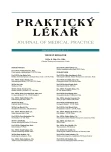Overactive bladder from the patient’s perspective
Authors:
R. Zachoval 1; J. Krhut 2; M. Záleský 1; V. Borovička 1
Authors‘ workplace:
Fakultní Thomayerova nemocnice, Praha
Urologické oddělení
Primář: doc. MUDr. Roman Zachoval, PhD.
1; Fakultní nemocnice Ostrava
Urologické oddělení
Primář: doc. MUDr. Jan Krhut, PhD.
2
Published in:
Prakt. Lék. 2011; 91(8): 466-470
Category:
Of different specialties
Overview
Aim:
Significant increase of interest in overactive bladder (OAB) in recent years has not been accompanied accordingly by an increased awareness among the general population. This was a reason for our survey about the important aspects of overactive bladder among normal population.
Patients and methods:
A questionnaire was set up to evaluate patient’s perspective of OAB. Questionnaires were distributed among specialists from out-patient and in-patient departments in the Czech Republic (83 urologists and 17 urogynecologists) selected from the database of the Czech Urological Society. These were then statistically evaluated.
Results:
Completely filled out questionnaires were obtained from 329 patients. In the group of patients 77 % were females and 23 % males and the incidence of OAB increased gradually from the fourth to the seventh decade of age. Patients fear incontinence the most, even more than cancer, surgical procedure and loss of job.
Patients have high expectations for pharmacological treatment of OAB, 95 % of them expect more than 50% improvement of symptoms but these expectations are fulfilled in only 31 % of patients.
The most important side effect of the pharmacological treatment of OAB is dry mouth (24 % of patients) and need to administer drugs more than once a day (13 % of patients). The majority of patients (90 %) have sufficiency of information about OAB but 91 % of patients prefer to obtain it from a specialist and not from multimedia.
Conclusions:
There are lot of different points of view on many aspects of OAB between medical professionals and general population. Therefore it is very important to acquire more data about this topic and to bring the different points of view together by means of better education and communication.
Key words:
overactive bladder, patients, quality-of-life.
Sources
1. Artibani, W. Outcomes in overactive bladder treatment: patient perception - a key to success. Eur. Urol. 2007, Suppl 6, p. 17-22.
2. Broďák, M., Holub, L., Košina, J. et al. Prevalence symptomů dolních močových cest a hyperaktivního močového měchýře u žen a mužů v běžné populaci. Urol. pro Praxi 2008, 9(1), s. 16-20.
3. Irwin, D.E., Milsom, I., Hunskaar, S. et al. Population-based survey of urinary incontinence, overactive bladder, and other lower urinary tract symptoms in five countries: results of the EPIC study. Eur. Urol. 2006, 50(6), p. 1306-1314.
4. Kučera, Z., Topinková, E., Jurásková, D., Müllerová, N. Inkontinence v ošetřovatelském kontextu [on-line]. Dostupné na www.inco-forum.cz/ download/Inkontinence.pdf.
5. Renganathan, A., Robinson, D., Cardozo, L. et al. Do women with overactive bladder have realistic expectations for therapy? Int. Urogynecol. J. 2010, 21(4), p. 409-414.
6. Steward, W.F., van Rooyen, J.B., Cundiff, G.W. et al. Prevalence and burden of overactive bladder in the United States. World. J. Urol. 2003, 20(6), p. 327-336.
Labels
General practitioner for children and adolescents General practitioner for adultsArticle was published in
General Practitioner

2011 Issue 8
- Hope Awakens with Early Diagnosis of Parkinson's Disease Based on Skin Odor
- Metamizole at a Glance and in Practice – Effective Non-Opioid Analgesic for All Ages
- Memantine Eases Daily Life for Patients and Caregivers
- Metamizole vs. Tramadol in Postoperative Analgesia
- Memantine in Dementia Therapy – Current Findings and Possible Future Applications
Most read in this issue
- Advances in operative treatment of fractures of upper and lower extremities
- Short intervention and first aid for patients with addictive diseases
- Study of four POCT systems for HbA1c measurement
- Problematic of doping in general practice
